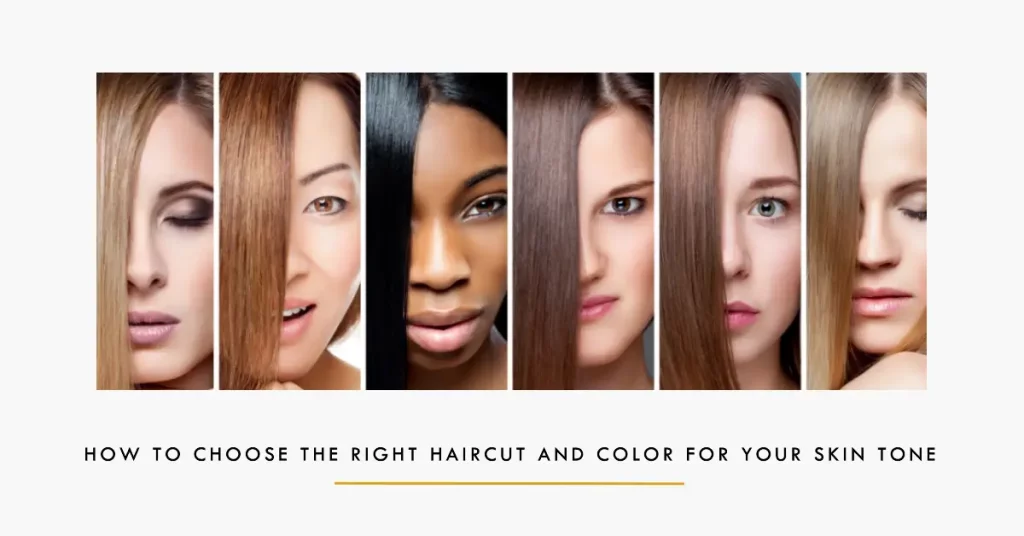
Your hair is an essential part of your overall look and can greatly impact how you feel about yourself. Choosing the right haircut and color for your skin tone is crucial to enhance your natural beauty. This article will help you understand your skin tone, find the perfect haircut, and select the right hair color to complement your complexion.
Understanding Your Skin Tone
Before diving into haircut and color options, it’s important to understand your skin tone. There are two key aspects to consider: your skin’s undertone and surface tone.
Determining Your Skin’s Undertone
Your skin’s undertone is the color beneath the surface. There are three main categories: warm, cool, and neutral. To determine your undertone, look at the veins on your wrist. If they appear greenish, you likely have a warm undertone. If they appear bluish or purplish, you have a cool undertone. If it’s hard to tell, you probably have a neutral undertone.
Identifying Your Skin’s Surface Tone
Your skin’s surface tone is the color you see at first glance. Surface tones can range from fair to deep. Keep in mind that surface tone and undertone are separate; someone with a fair surface tone can still have warm, cool, or neutral undertones.
Choosing the Perfect Haircut
Now that you know your skin tone, it’s time to find the ideal haircut.
Consider Your Hair Texture
Hair texture plays a significant role in determining which haircut will work best for you. Straight, wavy, curly, and coily hair types each have unique characteristics that should be considered when choosing a haircut.
Select a Haircut that Complements Your Skin Tone
The right haircut can enhance your skin tone and bring out your natural beauty. For example, a soft, layered haircut might work well for those with warm undertones, while a sleek, straight cut might suit those with cool undertones. Experiment with different styles to find what makes you feel most confident.
Selecting the Right Hair Color
The perfect hair color will complement your skin’s undertone and create a harmonious look.
Warm Undertones
For those with warm undertones, opt for hair colors with warm tones like golden blonde, caramel, or copper. These colors will enhance your skin’s natural warmth and create a flattering appearance. Avoid overly cool shades like platinum blonde, as they may make your skin appear washed out.
Cool Undertones
If you have cool undertones, choose hair colors with cool tones like ash blonde, cool brown, or icy platinum. These shades will complement your skin and make it glow. Steer clear of overly warm colors like golden blonde, as they may clash with your skin tone.
Neutral Undertones
If your undertone is neutral, you have more flexibility in choosing hair colors. You can experiment with both warm and cool shades to find the one that best suits your personal style and preferences.
Considering Different Hair Coloring Techniques
There are various hair coloring techniques available, such as balayage, ombre, and highlights. Each technique can create a unique look that complements your skin tone. For more information about different hair coloring techniques, check out 5 Popular Hair Coloring Techniques for Blondes.
Factors to Consider When Selecting Hair Color and Haircut
In addition to your skin tone, consider your lifestyle, maintenance level, and personal style when selecting a haircut and color. Some haircuts and colors require more upkeep than others, so think about how much time and effort you’re willing to invest in your hair.
Consulting a Professional Hair Stylist
When in doubt, consult a professional hairstylist like Krysta Kay. They can help you determine your skin tone and recommend the perfect haircut and color for your unique features. You can book a consultation at Krysta Kay’s website.
Maintaining Your New Haircut and Color
Once you’ve chosen the right haircut and color, it’s essential to maintain your new look. Learn how to care for your newly colored hair by reading Pro Tips for Caring for Newly Colored Blonde Hair.
Hair Treatments to Enhance Your Look
Consider hair treatments like Brazilian Blowouts to further enhance your new haircut and color. These treatments can help you achieve a smooth, frizz-free look that complements your skin tone.
Hair Extensions for Added Versatility
If you want to experiment with different lengths and styles, consider hair extensions. They can provide added versatility and help you achieve your desired look without committing to a drastic change.
Conclusion
Choosing the right haircut and color for your skin tone is essential for creating a flattering and cohesive look. By understanding your skin tone, considering various haircuts and colors, and consulting a professional hairstylist, you can find the perfect hairstyle to enhance your natural beauty.
FAQs
How do I determine my skin’s undertone?
Look at the veins on your wrist. If they appear greenish, you likely have a warm undertone. If they appear bluish or purplish, you have a cool undertone. If it’s hard to tell, you probably have a neutral undertone.
What hair colors work best for warm undertones?
Opt for warm shades like golden blonde, caramel, or copper to enhance your skin’s natural warmth.
What hair colors work best for cool undertones?
Choose cool shades like ash blonde, cool brown, or icy platinum to complement your skin tone and make it glow.
How often should I update my hair color?
The frequency of updating your hair color depends on the type of color and your personal preferences. Generally, it’s recommended to touch up your roots every 4-6 weeks for all-over color and 6-8 weeks for highlights or balayage. Consult your hairstylist for personalized advice.
Can I change my hair color if I’m not happy with the result?
Yes, you can change your hair color if you’re not satisfied with the outcome. However, it’s essential to consult a professional hairstylist to ensure that the color change is done safely and effectively.